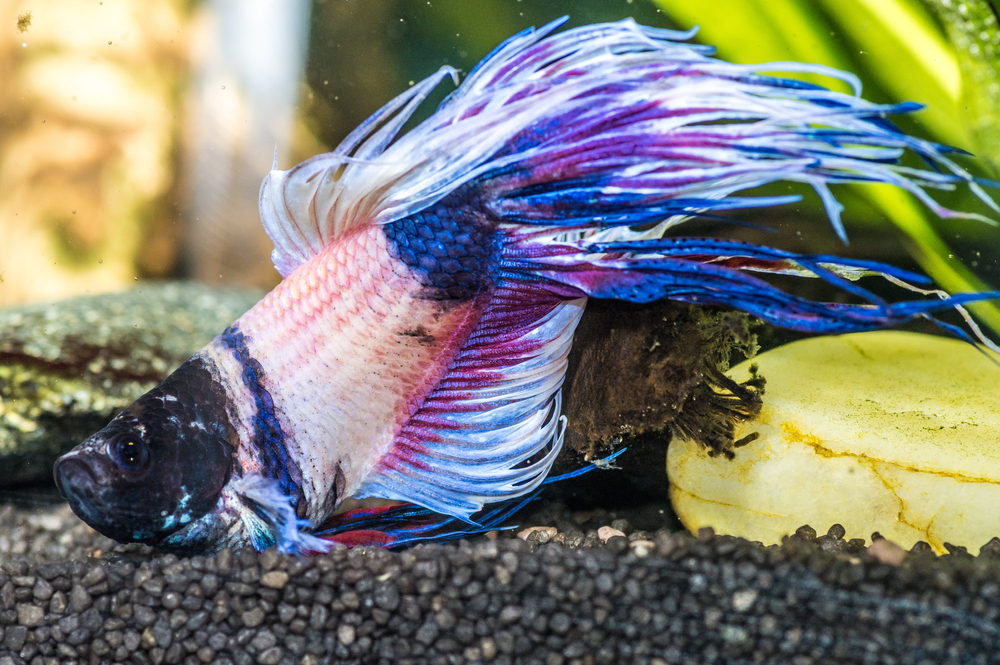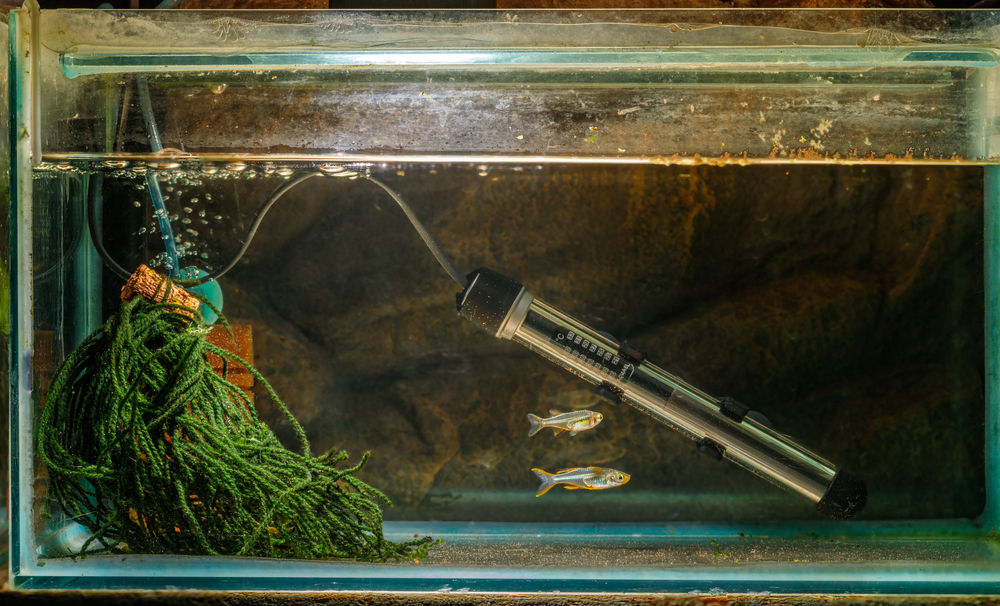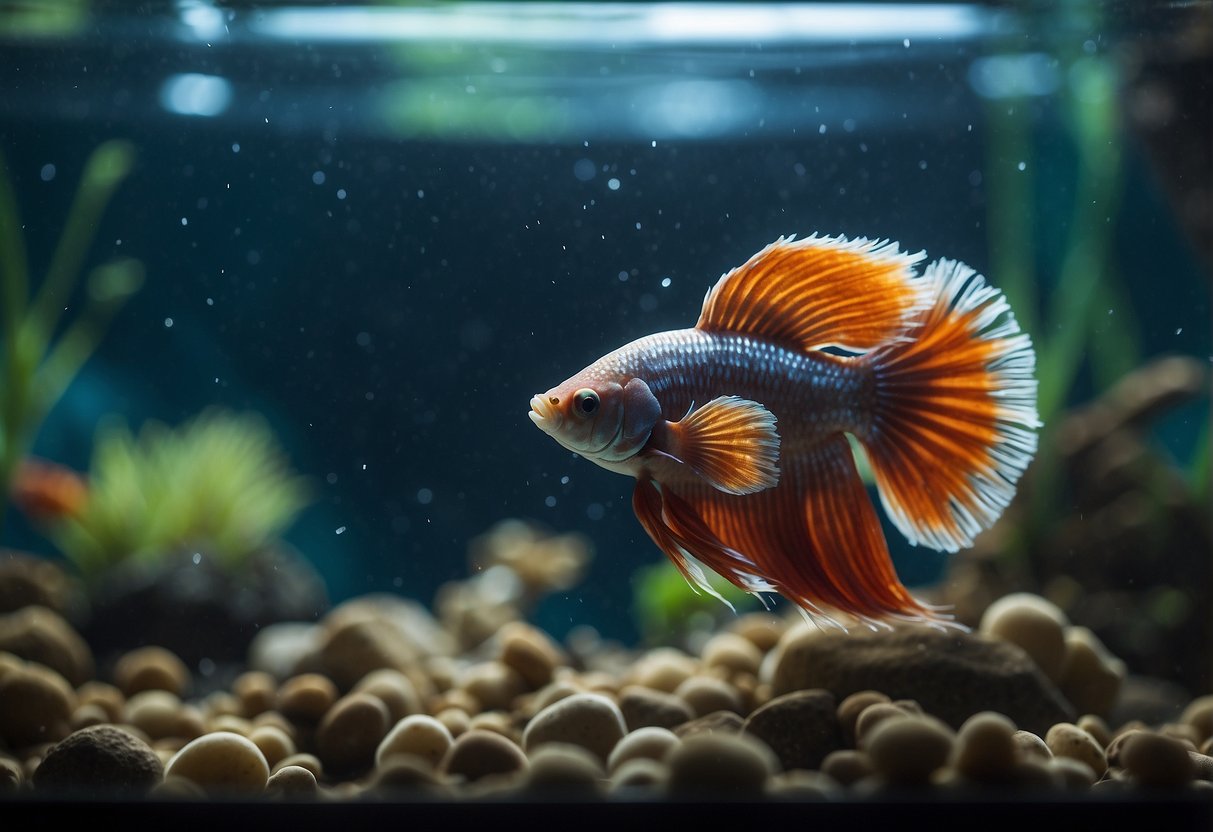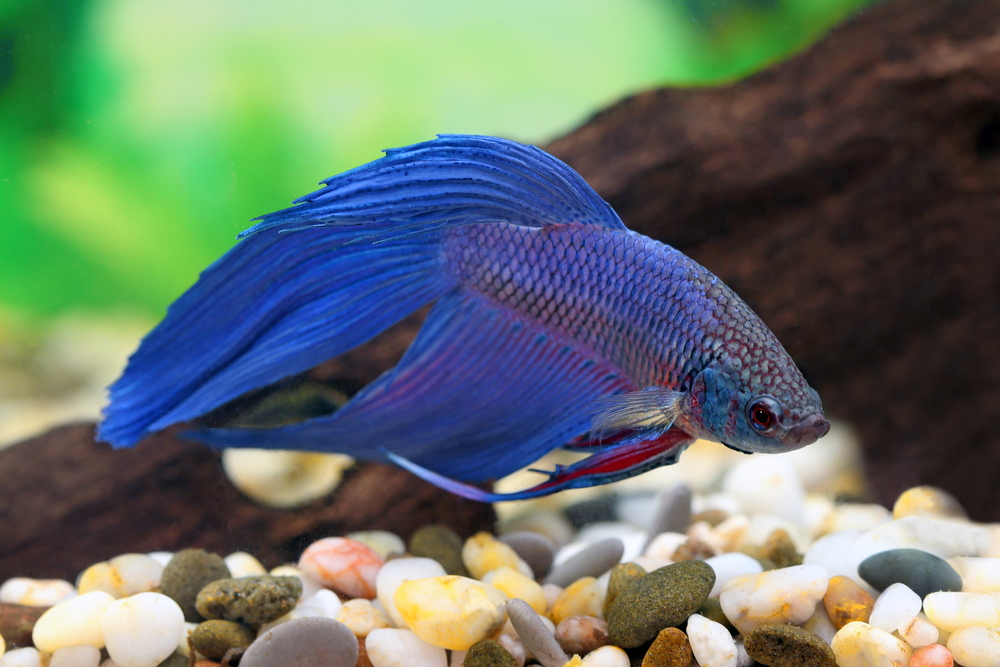Does your betta fish spend most of their time at the bottom of their tank? Bettas are naturally curious and active fish, so it’s understandable if you find this behavior problematic. While it’s not uncommon for betta fish to rest at the bottom occasionally, doing so persistently indicates an underlying health issue, which could be from their environment or their diet.

As an aquarist, whether you’re new to fish keeping or a seasoned vet, you should be able to decipher when your bettas are doing more than casually resting at the bottom of the tank. Being able to spot signs of trouble, understand potential causes, and know what actions to take are key to keeping your betta healthy.
Today’s guide is all about understanding this behavior: the signs, potential causes, and remedies. Let’s get right into it.
Contents
Betta Fish Laying on Bottom of Tank
Understanding your betta fish’s behavior is necessary for maintaining their health and well-being. Here, you’ll learn about typical resting patterns, environmental and dietary stressors, and healthy behavioral patterns.
Resting Patterns
Betta fish exhibit particular resting habits that are often mistaken for signs of illness. It’s normal for a betta fish to rest at the bottom of the tank periodically, especially at night.
Sleeping betta fish may lie without moving, which is part of their natural resting behavior. During the day, you might also find them taking short breaks nestled among plants or decorations.
Signs of Stress
Stress can manifest in betta fish through several behaviors. Watch out for signs like frequent hiding, reduced appetite, lethargy, rubbing against tank surfaces, or, in extreme cases, lying at the bottom of the tank. These signs indicate some level of discomfort or illness.
Healthy Betta Activities
A healthy betta is active and alert. So, you should closely monitor its swimming patterns, which include bouts of flaring its fins. You also want to watch out for an enthusiastic response to feeding. These activities indicate that your betta is thriving and not merely succumbing to laziness or a lack of stimulation.
Check out these other popular posts:
- Can Betta Fish Survive in Tap Water?
- How Much to Feed Betta Fish for Optimal Health and Longevity
- Can Male and Female Betta Live Together?
Common Health Issues in Betta Fish
Some health issues are common in betta fish, and they often lead to your betta resting at the bottom of the tank. These ailments can vary and may indicate a need for urgent care or adjustments in the aquarium parameters. Let’s take a look at some of these health issues:
Swim Bladder Disorder
Betta fish often experience “swim bladder disorder,” making it hard to swim properly. This disorder occurs when you overfeed your bettas or when they’re constipated.
You might see your betta fish struggling to swim, floating strangely at the top of the tank, or sinking to the bottom. The best action involves fasting the fish briefly or feeding them daphnia to alleviate constipation.
Disease and Infection

Disease and infection can manifest in various ways. Telltale signs include lethargy, loss of appetite, discoloration, or visible sores. An example of a common sickness among bettas is fin rot, which is a bacterial infection often marked by frayed or disintegrating fins.
Another common betta sickness is dropsy, which is indicated by an abnormally swollen body, often with raised scales. Whatever the case, you need to quarantine any sick betta and begin treatment with the appropriate medications.
The quarantine process prevents the potential spread of disease within the tank. It also allows for targeted treatment with medication in a controlled environment, promoting a faster recovery.
Injury and Stress
Injury is another cause leading to a betta remaining at the bottom. Sharp decorations or aggressive tank mates can harm your bettas. Likewise, being under too much stress can take its toll on bettas.
Common stressors include poor tank conditions and fluctuations in water chemistry. To mitigate this, you want to change the water regularly, pair them with compatible tankmates, avoid sharp decorations, and maintain a stable, stress-free environment.
Diet and Feeding Habits
Proper nutrition is important to prevent illnesses in betta fish. What you feed your betta fish affects how active and healthy they are. Giving them the right food prevents issues like lethargy and, ultimately, lying around at the bottom of their tank.
Common Diet-Related Issues
One of the most prevalent diet-related issues in betta fish is constipation. This often occurs when you feed them a diet high in fillers, which their digestive systems cannot process efficiently. Constipation can lead to a lack of energy, causing them to lie at the bottom of their tank due to discomfort.
Overfeeding is another common problem; giving your betta fish too much food can lead to bloating and digestive blockages. Monitor how much and how often you feed your betta to mitigate these risks.
Importance of a Balanced Diet
To provide a healthy diet for your betta, ensure it’s varied and rich in nutrients. A healthy diet typically includes:
- High-quality betta pellets are a staple.
- Frozen or live foods such as bloodworms or brine shrimp supplement the pellets.
- Vegetables like blanched peas can help prevent constipation.
Incorporating these foods into your betta’s diet keeps them more active and less likely to suffer from the lethargy associated with poor nutrition that can cause them to lay at the bottom of the tank.
Tank Setup and Maintenance

When setting up an aquarium for your betta fish, it’s imperative to focus on the tank size, decorations, and proper water temperature. Each component plays a vital role in the health and comfort of your betta.
Correct Tank Size
For your betta fish to be happy and healthy, they need a tank with a minimum holding capacity of 5 gallons. Small tanks get dirty fast because waste and debris accumulate. Larger tanks have more clean water space, which keeps things stable for your betta. Not only does a larger tank stay cleaner, but it also gives your betta more room to swim around the tank.
Aquarium Decorations and Hiding Spots
Bettas appreciate environments that mimic their natural habitats, which include plants and caves. You should add live plants to your betta’s tank to help with oxygenation and filtration.
You can also put in some fun decorations your betta can hide in. Smooth-edged artificial decorations or caves can provide necessary refuge without risking injury to the betta’s delicate fins.
Maintaining Water Temperature

A consistent and warm water temperature is vital for your betta health. You should use a reliable aquarium heater designed for your tank size to keep the water temperature between 78 and 80 degrees Fahrenheit. Regularly check with an aquarium thermometer to make sure the environment remains within this ideal range.
Interaction With Tank Mates
Introducing tank mates to your betta’s environment can significantly affect their behavior. While bettas are known for their aggressive tendencies, certain species can cohabitate with them peacefully. Snails or small shrimp can be suitable companions, providing interaction without overstimulating the betta.
When choosing tank mates, you should consider your betta’s temperament and the size of their tank to avoid cramped conditions that might lead to aggression.
When to Seek Veterinary Care

You want to consult a specialist when your betta fish shows persistent signs of distress or illness despite optimal tank conditions and care. While you may be able to tell if your betta is sick by looking for the different signs and symptoms, you still need a professional diagnosis to determine the best course of action.
Conclusion
It’s not good to have a betta always lying on the bottom of the tank. If you’re faced with this behavior, you need to keep a close eye on the fish. This includes monitoring their regular habits, adjusting their diets, and altering tank conditions. But sometimes, even with the best care, bettas can get sick.
If they still prefer the bottom of the tank, having taken care of these things, it’s time to call a specialist doctor with special tools and knowledge to find out what’s wrong and help your betta feel better. Remember, a healthy betta is an active betta. It should be swimming and showing off its beautiful fins.
Frequently Asked Questions
It’s a bit worrisome noticing your betta fish spending much time at the bottom of their tank. It’s a common concern for betta owners, so let’s further clarify with answers to some of the more common questions about this behavior.
What should I do if my betta fish is laying on the bottom of the tank?
If your betta fish is lying on the bottom, it could mean they are sick or stressed. Check the water temperature; ensure it’s not too cold or hot. Also, check the water quality and make sure it’s clean. If your fish doesn’t swim around or eat, it’s best to ask a fish expert for help.
Is it normal for my betta fish to stay still?
Betta fish can stay still for short periods, especially when resting or sleeping. However, if they remain still for a long time or are at the bottom of the tank, something is wrong. Keep an eye on them and ensure they are active and swimming around.
How to improve the water quality in your betta fish tank?
You can improve your betta fish’s water quality by changing some of the water regularly, using a water conditioner to remove harmful chemicals, and making sure the water temperature is right for your fish.
What is normal betta fish behavior?
Normal betta fish behavior includes swimming around their tank and being curious. They might flare their fins or show off their colors when seeing another fish. Betta fish are active and interactive, so if your fish behaves this way, it’s a good sign that it is happy and healthy.
Can a recent water change cause my betta fish to lay at the bottom of the tank?
Yes, if the new water has a different temperature or pH, it can cause shock. It’s advisable to acclimate a betta to new conditions slowly to prevent stress.
What are the signs of buoyancy issues in betta fish?
Signs of buoyancy in betta fish include swimming with difficulty, floating involuntarily, or being unable to rise from the bottom. Observing these signs can help you to know if your betta is suffering from swim bladder disorder.

Ian Sterling, founder of Fishlab.com, began his aquarium journey over 30 years ago, driven by a deep fascination for fish and their diverse personalities. His website, Fishlab.com, is dedicated to making fishkeeping accessible and enjoyable, offering beginner-friendly guidance, expert insights, and a community for aquarists to connect and share experiences.


